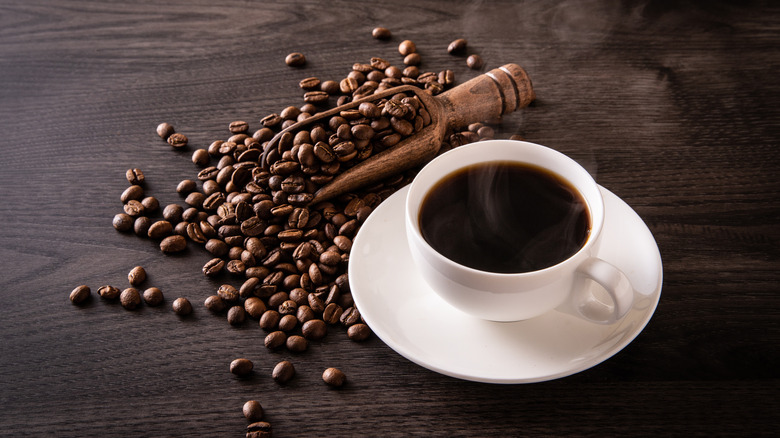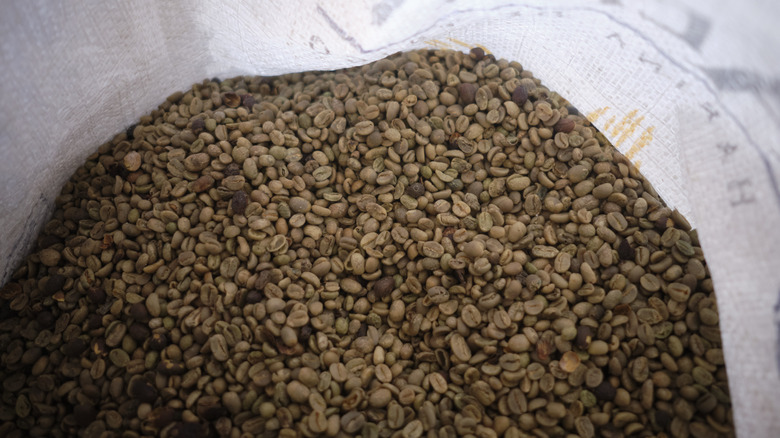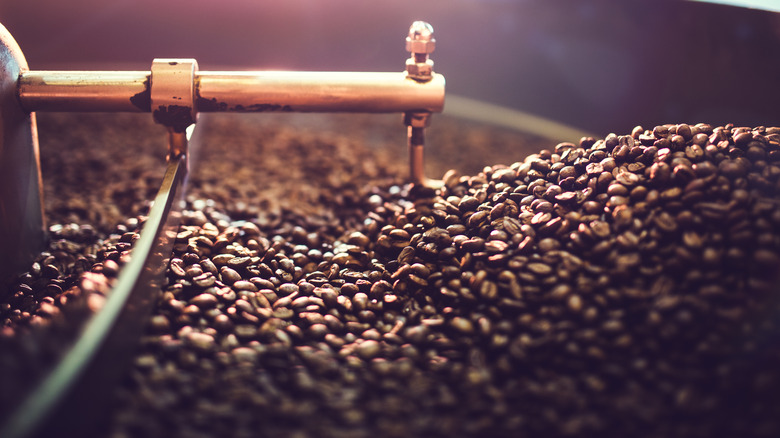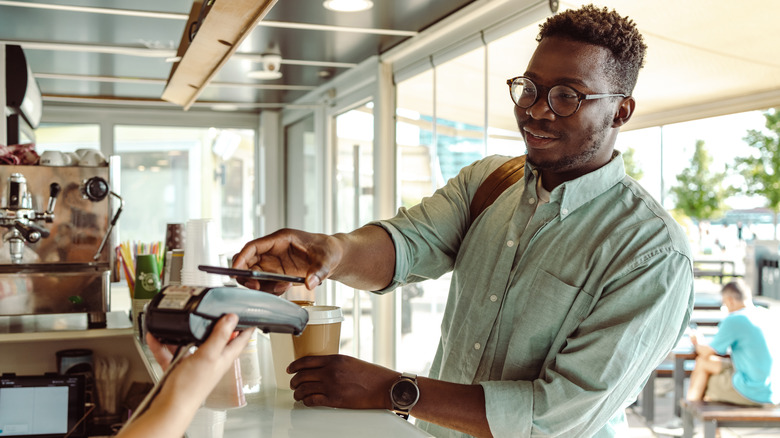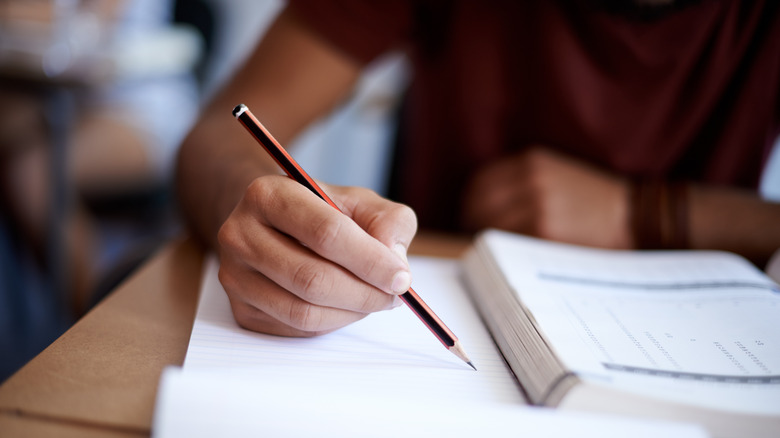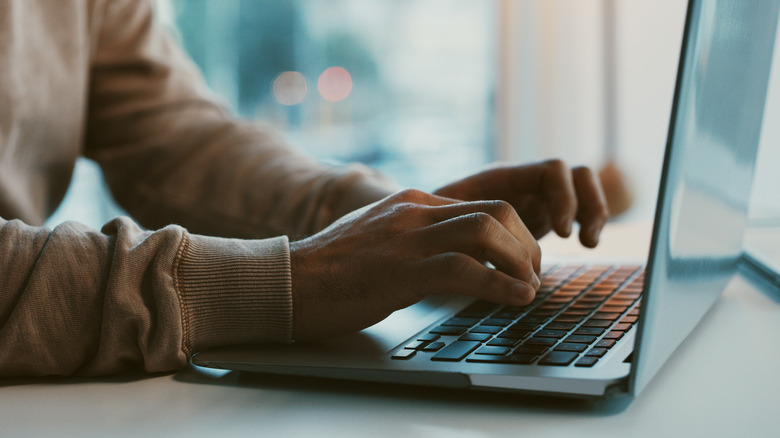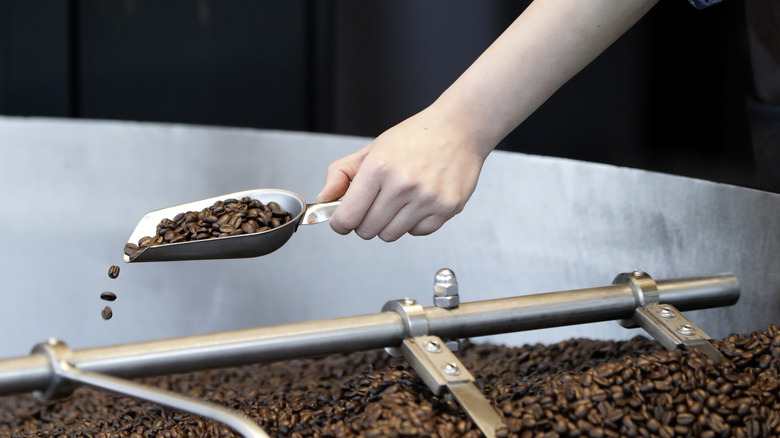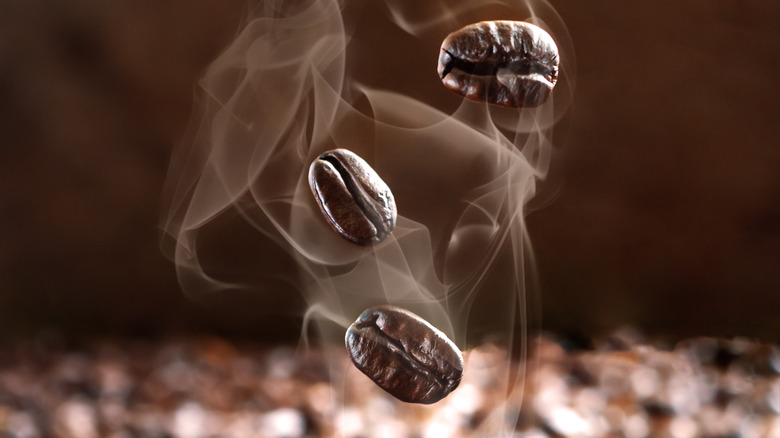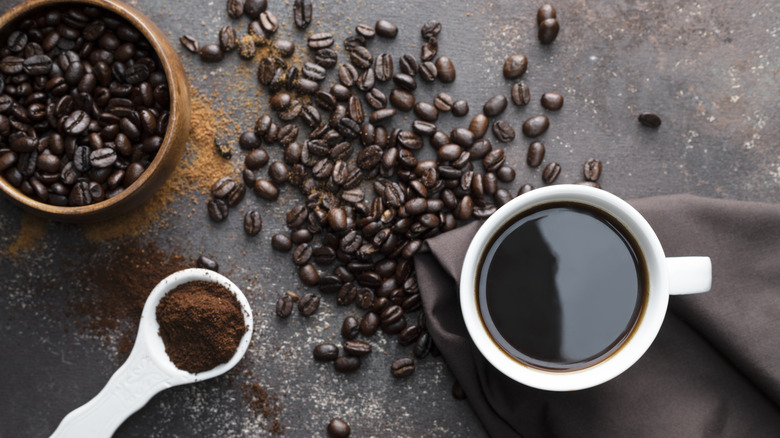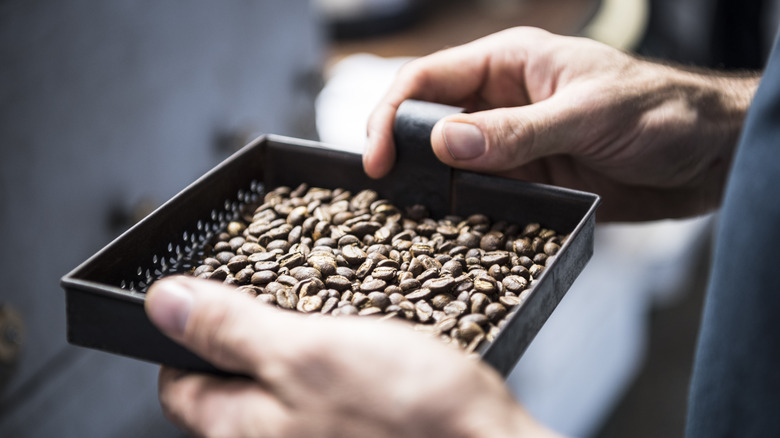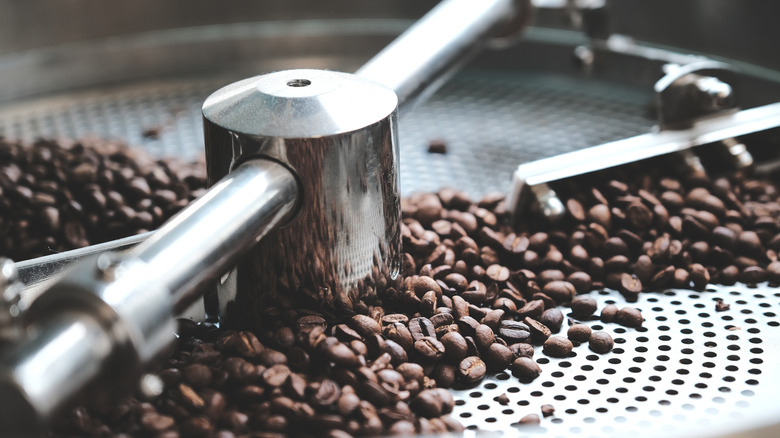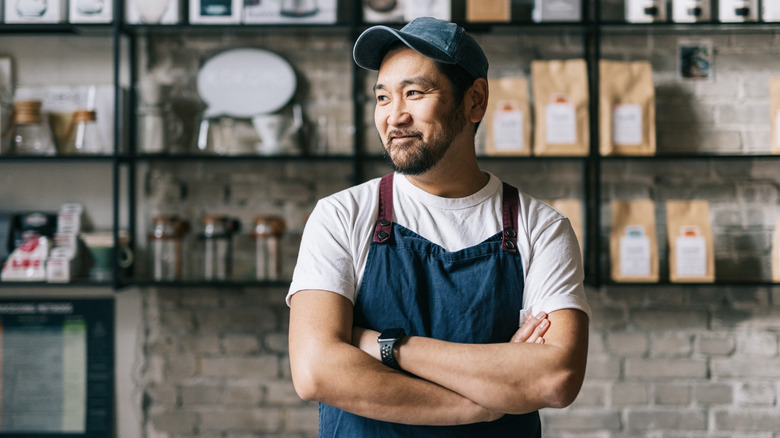12 Tips You Need When Roasting Coffee Beans At Home
Did you know you could roast your own coffee beans at home? And no, when we talk about roasting coffee at home, we don't mean buying a Nespresso and making a creamy latte straight off the bat. We mean taking it back a few steps even further.
That's right. You can buy what's called green coffee and roast it in order to make your perfect cup of joe. Roasting your own coffee is a pretty committed hobby, and there's a lot to know. From what equipment to buy, where to source your beans, how to get your desired type of roast (light, medium, dark), and what makes roasting coffee beans special, a lot goes into this skill. Because of this, we consulted with some experts in the field to help you become the coffee roaster master of your dreams — in your own home, at least. Here are some essential tips for roasting coffee at home, whether you've literally never done it before or are looking to level up your mad roasting skills.
1. Buy quality green coffee
Sadly, you can't walk into Trader Joe's, or even your local coffee shop, to buy the type of coffee beans needed to begin this adventure. You need to buy green coffee.
Green coffee beans are the beans that have been harvested right from the plants, vetted to make sure they're up to par, and then packaged and shipped to you — no roasting done yet. Green coffee beans are what coffee shop folks buy if they roast their own beans. For the at-home brewer, you'll need to take your green coffee beans, roast them to your desired level (more on that later), and once they've been roasted and cooled, you can put them into your grinder. After they've been ground, you can finally pull an espresso shot in your at-home machine or put the grounds in a Chemex or moka pot and get that sweet bean juice.
But if you can't get green coffee beans in-person (in most places), where do you source them? There are plenty of places online that sell green coffee (a quick Google search will reveal that), but something we learned from Matt Scottoline, Director of Coffee at ReAnimator Coffee Roasters in Philadelphia, is that in the case of green coffee, quality does usually equal price. "Coffee is a rare thing where, 90% of the time, I do think you kind of get what you pay for," Scottoline said. Reputable importers like Sweet Maria's are a solid place to get green coffee.
2. Prepare to spend a lot of time perfecting your roast
Now that you know a lot of the basics about what you're getting into with roasting your own coffee, you need to be aware that it is a time-consuming activity. Driving to a coffee shop, buying a cup of coffee, and drinking it is ridiculously faster than roasting your own beans, grinding them, brewing the coffee, crafting your beverage, and finally drinking it. But like any hobby, there are pros and cons.
Perfecting your roast doesn't just mean doing the same thing over and over until you found a flavor you enjoy. It's about putting in the time to hone your craft. "It's kind of like any cooking hobby," Scottoline adds. "If you get really into baking bread or something, that's kind of the same thing to me." He adds that anyone can bake bread, but if they're doing it because they're lazy and don't feel like driving to the store, it doesn't have quite the same meaning as wanting to understand the fermentation process behind the bread. Roasting coffee is the same concept — you have to do it because you're genuinely curious about the process, not because you don't feel like leaving your apartment and buying a cappuccino.
3. If you just want to save money, don't roast at home
Let's do the math. Say you want to cut costs in your budget by eliminating weekly (ahem, daily) coffee from Starbucks or your local coffee shop. But you still need caffeine to function, so you decide to take it a step further and invest in the bean roasting process. You can always use a pan on your stove (more on that to come), but you take the extra step and purchase a popcorn machine. On average, a popcorn machine costs about $25.
Once you've bought that (don't forget the cost of shipping and taxes), you need to buy the actual green coffee. Let's assume you start out small with a pound of green coffee (yes, that's typically the smallest amount you can purchase at a time). That costs approximately $8. You also need to own a grinder for the beans (anywhere between $10 and $200), a machine to brew the grounds (again, between $10 for a pour-over or thousands of dollars for a nice espresso machine), and any milk, creamers, syrups, sauces, toppings, glasses, fancy ice molds, and any other extras your heart desires. You will probably save money doing this, but if you don't enjoy it, all that extra time (and counter space) wasted on something you're not passionate about really isn't worth the few bucks saved in the long run. You have to be in it for more than saving a bit of money.
4. Popcorn machines work just fine
Yes, you read that correctly. You can absolutely use a popcorn-popping machine to roast your coffee beans. But there are some caveats to be aware of.
Trevor Szewczyk, head roaster at Rival Bros Coffee Roasters in Philadelphia, notes that "Part of it has to do with the fact that you're using a heating element." They also go on to note that it's worth trying out even if you can afford a fancy, high-end roaster. "If you have the money for this, still mess around with a pan or popcorn popper and get a feel for it," Szewczyk said. The science behind using popcorn poppers is simple: The heat heats up the coffee beans, and the shape and design of the popcorn popper allow you to keep the beans moving at (mostly) consistent intervals. Do note, though, that popcorn poppers are meant to be used for, well, popcorn, and that it may break after a while, especially if it's an older machine you're dusting off from your basement to try out. But they are effective, as is just heating the beans up on a quality pan on the stove. With anything involving cooking and heat, be sure to be working in a well-ventilated area and pop a window open for good measure.
5. Use the scientific method
We're taking it back to high school science class. Do you recall the scientific method? If not, here's a crash course: You have your question, then perform your research, form a hypothesis, test with your experiment, analyze your data, and report your conclusions. But how does this relate at all to coffee roasting?
Think about it: Trying to figure out how you like your coffee roasted is all about trial and error. And the most effective way to execute trial and error is through the scientific method. "Be consistent with your variables ... so you don't throw off your scientific method," Scottoline notes. "You really do have to treat it like you're doing a science experiment." For instance, only changing one factor at a time, like the temperature you have it at or the amount of beans you're roasting at a time, is important to identify what specifically you like and don't like about each batch. If you change a bunch of factors at once, how are you supposed to know what worked? Also, the scientific method involves being very detailed in your notes, something both Scottoline and Szewczyk emphasize in the roasting process. "Having a timer on hand and taking detailed notes," Szewczyk explains, "is about doing the math to figure out how dark or developed you want your coffee."
6. Don't buy into expensive software
While taking notes on your coffee roasting journey by hand seems tedious, we promise no shortcut would be worth it. Sometimes, doing things the traditional way is helpful for a reason. But don't take our word for it. "There is software out there that, I wouldn't say to go buy Cropster for yourself if you want to roast at home," Szewczyk said. "But there are ways to calculate what percentage of my roast was spent in development time so you can have a barometer for your own roasting."
If you've never heard of it, Cropster is the software that pretty much all coffee roasters use to track their roasts. It's great for big batches of coffee and businesses that do roasting all day long, but for the casual hobbyist, there's really no reason to buy into it – especially when half the fun of getting into coffee roasting is in the trial and error. Figuring out the success of how many minutes after the first crack in the beans you enjoy your coffee is a liberating moment, and knowing that you perfected your recipe all by yourself makes the moment that much sweeter. It's already expensive to buy all of this equipment, so there's no need to have software do your math for you, especially if you're roasting for only one or two.
7. Keeping the beans moving is key
Now that we're all on the same page about what equipment beginners can buy, where to source your green coffee, and some dos and don'ts of getting into coffee roasting, the fun can really begin. Roasting coffee is all about timing, but getting your beans cooked to the ideal millisecond isn't going to matter if only half of your batch is how you like it.
You need to keep the beans moving if you want them all to reach an equal level of being cooked. If you've ever worked in a coffee shop or perhaps peeked your head behind the counter, you might have seen a huge, round, machine slowly circling the coffee beans around. This is essentially the effect of washing your clothes by hand or in a washing machine – that roasting machine is doing all the heavy lifting of keeping the beans moving. If you're working with a pan on a stove or a popcorn popper, or even if you invested in an at-home roasting machine, you need to keep those beans moving. What's the point of putting in all that work if some of the beans are perfectly cooked, and the others are still green? You want every bean to be at the same level, or at least as close together as you can get them all.
8. It's all about the first crack
By this point, you've heard us mention "first crack" several times, and you might be wondering what that means. Let us enlighten you with the scientific process of how coffee beans actually get roasted. "When it comes to roasting, a lot of people will talk about it in three sections," Szewczyk notes. "You have your drying phase, where you're sort of steadily getting the beans acclimated to the heat ... And then you are upping the heat as the bean takes on more heat because at this point you're basically staving off water and keeping out the moisture content of the beans."
"That's a drying phase, and that's when the coffee transitions from green to a mustardy yellow," Szewczyk says. "At that point, you are trying to get the beans to boiling point, which takes us to first crack." The first crack is when all of the water content has (finally) exited the beans, and they get so dry that they crack. You'll actually see roasters sometimes put their ears up against the machines to listen for that first crack, as that's an important indicator of the roasting process. Once the beans have reached the first crack, it's all a timing game after that. The first crack is when beans are at light roast, and the time between the first crack and the second crack is considered medium roast. After the second crack, it's called a dark roast.
9. Start by experimenting with dark roasts
You might think that starting with a light roast might be easiest since it's earlier in the overall roasting process, but it's much easier for beginners to start with a dark roast. "I think the biggest thing with all those cracking phases is just that they're nice markers to work off of as you're doing that scientific method of figuring out how you want to roast," Scottoline says. "Dark roast is definitely the easiest because when you dark roast the coffee, you don't really taste the coffee that much itself ... So you can't really go wrong, and if you want a darker roast at home, you can kind of not stress too much about [it]. I'm not trying to write off dark roasting, but the quality of coffee is not quite as important when you get into dark roasting."
Basically, Scottoline notes that if you enjoy burnt toast, dark roast is a similar situation. Because the window for light and medium roasts is so small, it can be stressful to reach the exact roast you're looking for. But with dark roast, you can let the beans hit both first and second crack, and then you can go ahead and experiment with your dark roasts. Play with how long after the second crack you keep the beans in there to try out the different types of dark roasts. There are a lot of cups of coffee coming your way.
10. Level up by trying different timings after first crack
Once you feel you've mastered the art of the dark roast, you can level up even more by going into the light-to-medium roast territory. As we mentioned before, that's the time at and after the first crack, but before the second crack occurs (take a sip of coffee every time we say crack).
The reason this is more advanced than a dark roast territory is that it is so incredibly precise, and every little variable can affect the flavor of the final product so much. It's also important to note that different bean heating methods can cause different reaction timings in your beans, so even if you use the same one-pound sack of green coffee to roast on the stove, you will probably get different results if you roasted it using the popcorn popper. And that's including if you use the exact same temperatures and timings and everything. Every little detail matters and that's the most apparent in the light to medium roast range.
11. Invest in an at-home roaster if you have the space
Are you sick of hearing about pans and popcorn poppers? Us too. It's time to talk about the most advanced tool you can possibly buy to level up your coffee roasting game: an at-home roaster. No, you won't be buying a gigantic cylinder roaster for making coffee for you and yours (unless you have a spare bedroom you've been dying to convert into a coffee shop), but you can invest in a countertop roasting machine.
One nice perk about investing in a coffee roaster (priced anywhere from $95 to more than $600), is that a quality one should come with a cooling feature installed. We've talked a lot about roasting the coffee, but we should also mention that cooling it is just as important. Like a good batch of homemade cookies, you may know that cookies continue to cook when they're out of the oven, but still on the pan, because the pan holds heat, which will continue to bake the cookies until it's cooled down. Coffee works the same way, and if you have the space and money, a nice perk of coffee roasting machines is that they can cool your coffee for you so that you're not scrambling to take it off the pan or the popcorn popper.
12. Work with local coffee shops for deals on green coffee suppliers
Roasting coffee is like any other hobby in that you're able to connect with others who share your passion. You can chat online, follow people on social media, and confer with your local barista about the trials and tribulations of roasting coffee. Even if they do it on a larger scale than you, it's still enjoyable to speak the language of roasting.
Beyond building your coffee roasting community, if you feel you have a strong enough relationship with your local (not big corporate chain) barista, it never hurts to inquire about working with your local shop for deals on green coffee suppliers. If you've bought every green coffee from Sweet Maria's and you're itching to expand your hobby, it can't hurt to ask if your local shop is looking for someone to work with them on it. You'll be able to get your coffee bag, and the shop will gain another person to help navigate the bidding process on green coffee. "If you're friends with your local roaster or you're friends with somebody that owns a coffee company, when it comes to bidding on super expensive auctions, people are always happy to have a little bit of help getting those," Szewczyk notes. "Offsetting those costs for the roaster, of course, is always a big cost ... I think it'd eliminate some of the feelings that there are middlemen between you and your green coffee, and being able to have fresh roasted coffee at home."
